Toyota Supra 1998 Owner’s Manual
SUPRA (U)
Part 1
OPERATION OF
INSTRUMENTS AND
CONTROLS—
Chapter 1−1
Overview of instruments and controls
DInstrument panel overview
DInstrument cluster overview
DIndicator symbols on the instrument panel
1

SUPRA (U)
Instrument panel overview
2
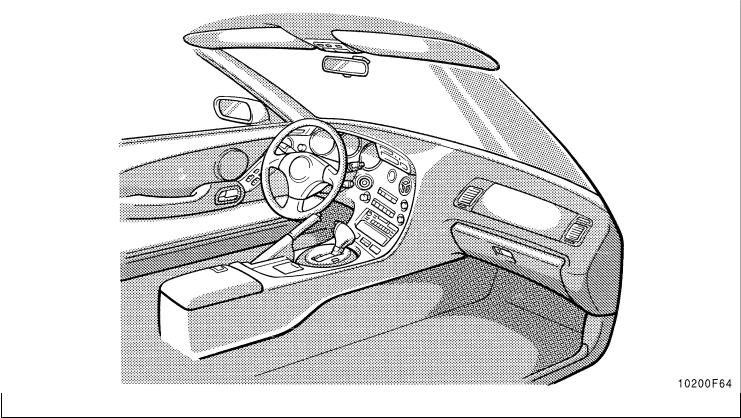
SUPRA (U)
3
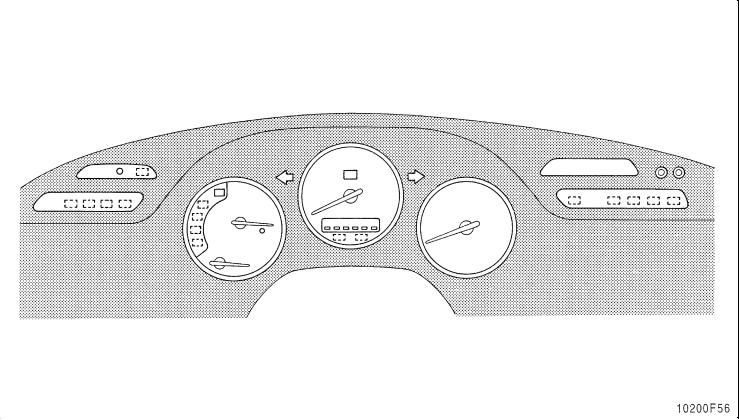
SUPRA (U)
Instrument cluster overview
4
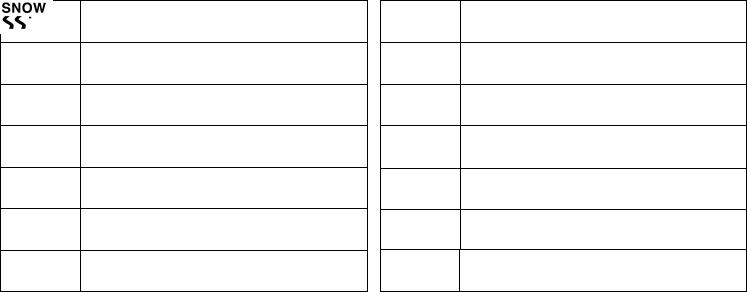
Indicator symbols on the instrument panel
Master warning light 1
Brake system warning light 1
Seat belt reminder light 1
Discharge warning light 1
Malfunction indicator lamp 1
Low oil pressure warnig light 1
Low engine oil level warning light 1
SUPRA (U)
Anti-lock brake system warning light 1
Open door warning light 1
Rear light failure warning light 1
SRS airbag warning light 1
Traction control system off indicator/warning light 1
Slip indicator light
Snow mode indicator light
5
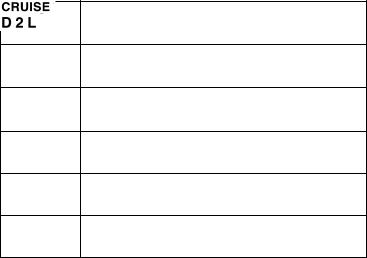
SUPRA (U)
Turn signal indicator lights
Headlight high beam indicator light
Overdrive−off indicator light
Automatic transmisson manual mode indicator light 2
Automatic transmisson indicator lights
Cruise control indicator light 3
1: For details, see ”Service reminder indicators and warning buzzers” in Chapter 1−5.
2: If this light flashes, see ”Automatic transmission” in Chapter 1−6.3: If this light flashes, see ”Cruise control” in Chapter 1−6.
6
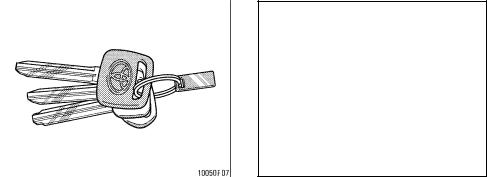
Part 1 OPERATION OF INSTRUMENTS AND CONTROLS—
Chapter 1−2
Keys and Doors
DKeys
DSide doors
DPower windows
DBack door
DHood
DTheft deterrent system
DFuel tank cap
DSport roof
SUPRA (U)
Keys
The master key works in every lock. The subkey will not work in the glovebox.
To protect things locked in the glovebox when you have your vehicle parked, leave the subkey with the attendant.
Since the side doors and back door can be locked without a key, you should always carry a spare master key in case you accidentally lock your keys inside the vehicle.
Keep the key number plate in a safe place such as your wallet, not in the vehicle.
If you should lose your keys or if you need additional keys, duplicates can be made by a Toyota dealer using the key number.
You should also put a copy of the key number with your important papers.
7

SUPRA (U)
Side doors
LOCKING WITH KEY
Turn the key toward the front of the vehicle to lock and towards the back to unlock.
Both doors lock and unlock simultaneously with either door. In the driver’s door lock, turning the key once will unlock the driver’s door and twice in succession will unlock both doors simultaneously.
LOCKING WITH INSIDE LOCK KNOB
Turn the lock knob forward to lock and backward to unlock the door.
Closing the door with the lock knob in the lock position will also lock the door. Be careful not to lock your keys in the vehicle.The door cannot be locked if you leave the key in the ignition switch.
LOCKING WITH POWER DOOR LOCK SWITCH
To lock both of the doors simultaneously, push the power door lock switch on the LOCK side. Pushing on the UNLOCK side will unlock them.
8

SUPRA (U)
Power windows
 CAUTION
CAUTION
Before driving, be sure that the doors are closed and locked, especially when small children are in the vehicle. Along with the proper use of seat belts, locking the doors helps prevent the driver and passengers from being thrown out from the vehicle during an accident. It also helps prevent the doors from being opened unintentionally.
The windows can be operated with the switch on each side door.
The power windows work when the ignition
switch |
is in |
the ”ON” |
position. |
However, |
if both |
side |
doors are |
closed, |
they work |
for 60 seconds even after the ignition switch is turned off. They stop working when either side door is opened.
OPERATING THE DRIVER’S WINDOW
Use the switch on the driver’s door.
Normal operation: The window moves as long as you hold the switch.
To open: Lightly pull down the switch. To close: Push up the switch.
Automatic operation (to open only): Pull the switch completely down and then release it. The window will fully open. To stop the window partway, lightly push the switch up and then release it.
9

SUPRA (U)
OPERATING THE PASSENGER’s WIN-
DOW
Use the switch on the passenger’s door. The driver’s door also has a switch that controls the passenger’s window.
The window moves as long as you hold the switch.
To open: Pull down the switch. To close: Push up the switch.
If you push in the window lock button on the driver’s door, the passenger’s window cannot be operated.
 CAUTION
CAUTION
To avoid serious personal injury, you must do the following.
DAlways make sure the head, hands and other parts of the body of all occupants are kept completely inside the vehicle before you close the power windows. If someone’s neck, head or hands gets caught in a closing window, it could result in a serious injury. When anyone closes the power windows, be sure that they operate the windows safely.
DWhen small children are in the vehicle, never let them use the power window switches without supervision. Use the window lock button to prevent them from making unexpected use of the switches.
DNever leave small children alone in the vehicle, especially with the ignition key still inserted. They could use the power window switches and get trapped in a window. Unattended children can become involved in serious accidents.
10

SUPRA (U)
Back door— |
—Lock release lever |
 CAUTION
CAUTION
Keep the back door closed while driving. This not only keeps the luggage from being thrown out but also prevents exhaust gases from entering the vehicle.
To open the back door from the outside, insert the key and turn it clockwise.
See ”Luggage stowage precautions” in Part 2 for precautions to observe in loading luggage.
To close the back door, lower it and press down on it. After closing the back door, try pulling it up to make sure it is securely closed.
To open the back door from the driver’s seat, pull up on the lock release lever.
11
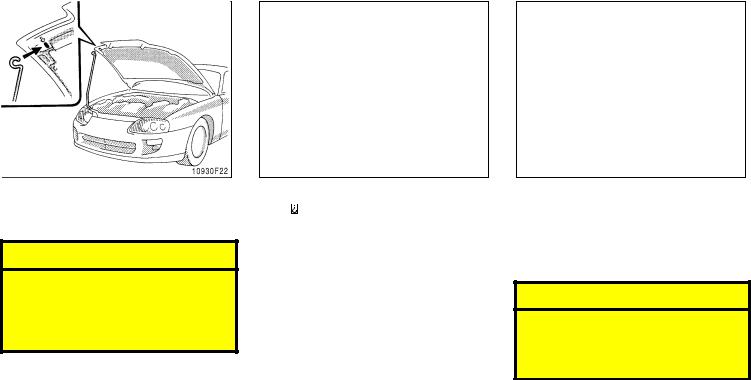
SUPRA (U)
Hood
To open the hood, do the following.
1. Pull the hood lock release lever. The hood will spring up slightly.
 CAUTION
CAUTION
Before driving, be sure that the hood is closed and securely locked. Otherwise, the hood may open unexpectedly while driving and an accident may occur.
2. In front of the vehicle, |
pull |
up |
on |
the a uxilialy catch lever |
and |
lift |
the |
hood. |
|
|
|
3.Hold the hood open by inserting the support rod into the slot.
Before closing the hood, check to see that you have not forgotten any tools, rags, etc. and return the support rod to its clip− this prevents rattles.
 CAUTION
CAUTION
After inserting the support rod into the slot, make sure the rod supports the hood securely from falling down on to your head or body.
12
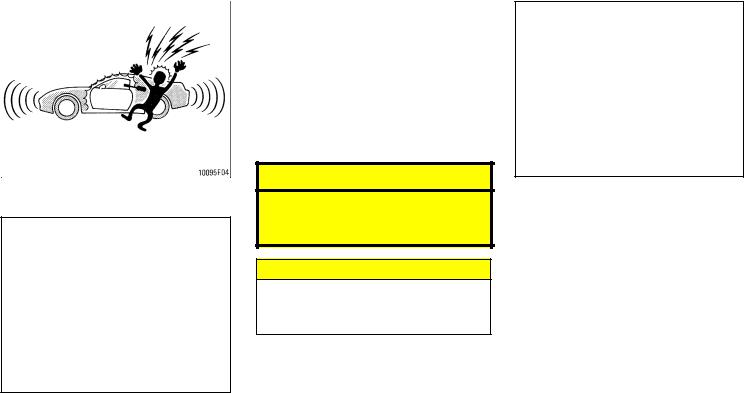
SUPRA (U)
Your Supra has two hood locks at the |
|
front edge of the hood. |
|
To close the hood, |
lower the hood until it |
is about 30 cm (12 |
in.) about the engine |
compartment and release it. If the hood is |
|
still not fully closed, press down on it |
|
above the two hood |
locks. Make sure the |
hood is locked securely.
If you notice while driving that the hood is not securely locked, stop the vehicle at once and close the hood.
 CAUTION
CAUTION
When closing the hood, be careful not to get your hands caught between the hood and the vehicle body.
NOTICE
Do not press hard on the hood except above the hood locks, or you may deform the hood.
Theft deterrent system
To deter the vehicle theft, the system is designed to give an alarm and keep the engine from being started if any of the side doors, back door or hood is forcibly unlocked or the battery terminal is disconnected and then reconnected when the vehicle is locked.
The alarm blows the horn intermittently and flashes the headlights, tail lights and other exterior lights. The engine cannot be started because the starter circuit will be cut.
13
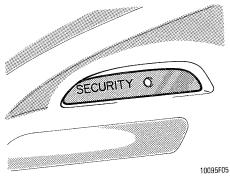
SUPRA (U)
SETTING THE SYSTEM
1.Turn the ignition key to the ”LOCK” position and remove it.
2.Have all passengers get out of the vehicle.
3.Close and lock all the side doors, back door and hood.
The indicator light will come on when all the side doors, back door and hood are closed and locked.
As the side doors are locked, the system will give you a preparation time of 30 seconds before the setting, during which the side doors, back door and hood may be opened to prepare for the setting.
Be careful not to use the key when opening any side door. This will cancel the system.
4.After making sure the indicator light starts flashing, you may leave the vehicle.
The system will automatically be set after the preparation time passes. The indicator
light will flash |
to show the |
system is set. |
If any of the |
side doors, |
back door or |
hood is open at that time, the setting is interrupted until it is closed and locked.
Never leave anyone in the vehicle when you set the system, because unlocking from the inside will activate the system.
WHEN THE SYSTEM IS SET
Activating the system
The |
system |
will give the alarm and cut |
the |
starter |
circuit under the following |
conditions:
DIf any of the side doors, back door or hood is unlocked without using the key
DIf the battery terminal is disconnected and then reconnected
After one minute, the alarm will automatically stop with the starter circuit cut kept on.
Reactivating the alarm
Once set, the system automatically resets the alarm each time all the side doors, back door and hood are closed after the alarm stops.
The alarm will be activated again under the following conditions:
DIf any of the side doors, back door or hood is opened
DIf the battery terminal is disconnected and then reconnected
Stopping the alarm
Turn the ignition key from the ”LOCK” to ”ACC” position. The alarm will be stopped with the starter circuit cut kept on. Stopping the alarm in this manner will keep the alarm from being reactivated when any of the side doors, back door or hood is opened.
Interrupting the setting
With the system set, the back door can be opened by using the key without setting off the system. While the back door is open, the setting is interrupted and the side doors and hood may be opened in addition. However, when the battery terminal is disconnected and then reconnected, the system is activated.
14
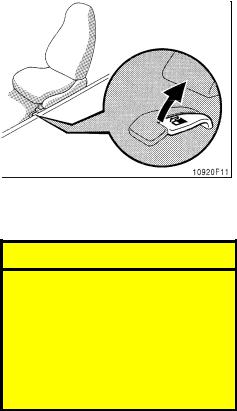
Close and lock the side doors and hood, and the system will automatically be reset after two seconds when the back door is closed with the key removed.
CANCELLING THE SYSTEM
Unlock either side door with the key. This cancels the system completely and the starter circuit cut will be cancelled at once.
INDICATOR LIGHT
The |
indicator light gives the following |
three |
indications. |
FLASHING—The system is set. You need the key to open the side doors, back door and hood.
ON—The system will automatically be set when the time comes. The side doors, back door and hood may be opened without a key.
OFF—The system is inactive. You may open any of the side doors, back door and hood.
SUPRA (U)
TESTING THE SYSTEM
1.Open the windows.
2.Set the system as described above. The side doors should be locked with the key. Be sure to wait until the indicator light starts flashing.
3.Unlock either side door from the inside. The system should activate the alarm.
4.Cancel the system by unlocking either side doors with the key.
5.Repeat this operation for the other side doors, back door and hood. When testing on the hood, also check that the system is activated when the battery terminal is disconnected and then reconnected.
If the |
system does not work properly, |
have it |
checked by your Toyota dealer. |
Fuel tank cap
1.To open the fuel filler door, pull the lever up.
When refueling, turn off the engine.
 CAUTION
CAUTION
DDo not smoke, cause sparks or allow open flames when refueling. The fumes are flammable.
DWhen opening the cap, do not remove the cap quickly. In hot weather, fuel under pressure could cause injury by spraying out of the filler neck if the cap is suddenly removed.
15
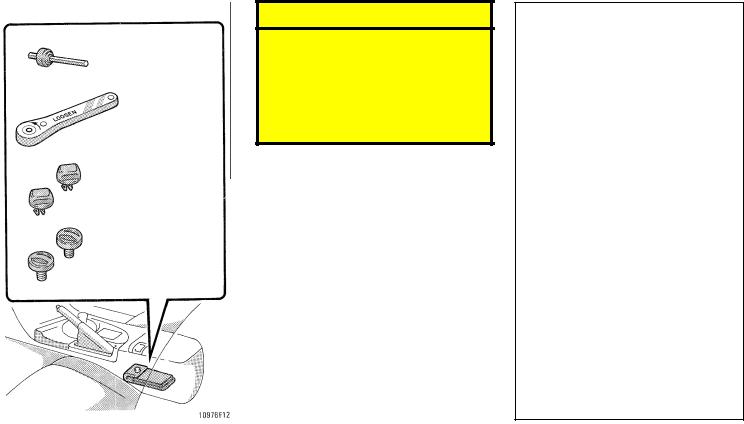
2. To |
remove the fuel tank cap, turn |
||
the |
cap |
slowly |
counterclockwise, |
then pause slightly before removing |
|||
it. After |
removing |
the cap, hang it |
|
on |
the cap hanger. |
|
|
It is not unusual to hear a slight swoosh when the cap is opened. When installing, turn the cap clockwise till you hear a click.
If the cap is not tightened securely, the malfunction indicator lamp comes on. Make sure the cap is tightened securely.
The indicator lamp goes off after driving several times. If the indicator lamp does not go off, contact your Toyota dealer as soon as possible.
SUPRA (U)
Sport roof—
—Detaching from vehicle
 CAUTION
CAUTION
DMake sure the cap is tightened securely to prevent fuel spillage in case of an accident.
DUse only a genuine Toyota fuel tank cap for replacement. It has a built− in check valve to reduce fuel tank vacuum.
16
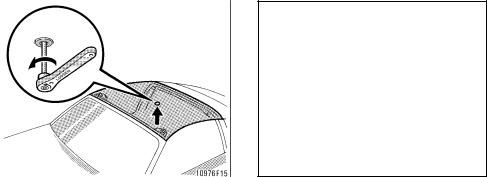
SUPRA (U)
1.Get the tool bag out of the console box.
In the tool bag, you will find a special kit consisting of:
DWrench and handle
—For turning the center lock and the front and rear bolts
DCaps
—For covering the front bolts
DPlugs
—For stopping up the rear holes
2. Face the ”LOOSEN” side of the handle toward you and insert the wrench into the handle.
3.Unlock the center lock by inserting the wrench and turning it a 1/4 turn counterclockwise.
Before detaching the sport roof from the vehicle, fully open both of the side doors and windows, and clear the seats.
17
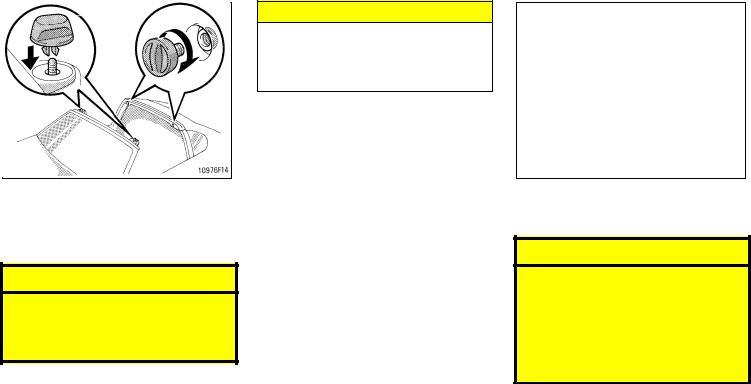
SUPRA (U)
NOTICE
Take care not to hit the sport roof against the vehicle body to avoid damage to the roof when detaching the roof.
4.Loosen the bolts in the order shown by turning the wrench counterclockwise. Then lift up the front edge of the sport roof and lift off the roof forward.
 CAUTION
CAUTION
Be careful not to get your hands or fingers caught between the sport roof and the vehicle body when detaching the roof.
5. After removing the roof, put the caps on the front bolts and insert the plugs into the rear holes.
 CAUTION
CAUTION
DDo not stick your head, arms or any objects out of the opening while the vehicle is moving.
DNever attempt to remove the roof while driving.
DDo not sit on top of the vehicle around the opening.
18
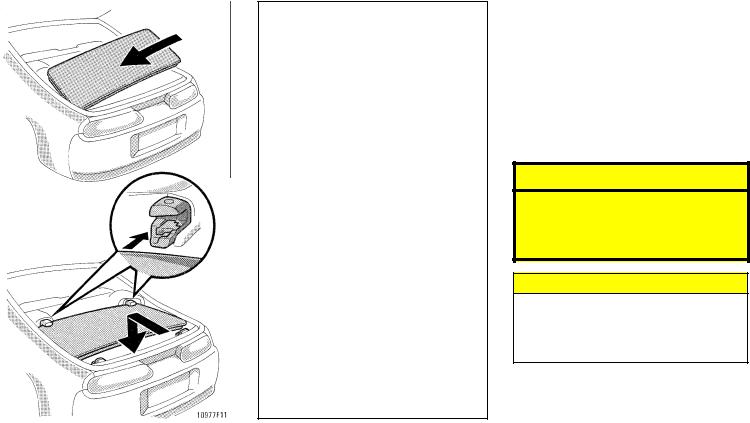
—Stowing in luggage compartment
1.Open the back door and set up the rear holders as shown above.
Before stowing the roof in the luggage compartment, be sure to remove the luggage cover. (See ”Luggage cover” in Chapter 1−8.)
SUPRA (U)
2.Put in the roof from the left side as shown. Then insert the front edge of the roof in the front holders, and engage the rear edge with the rear holders.
Put the front edge on the triangle marks of the front holders.
To engage the rear edge of the roof with the rear holders, put the rear edge on the holders while pushing the front edge fully forward against the front holders.
 CAUTION
CAUTION
To minimize the risk of personal injury, make sure all four corners of the roof are securely locked in the holders after installation.
NOTICE
To avoid damage the roof panel, do not press on the center of the stowed roof panel and do not put anyting on the stowed roof panel.
19

—Reinstalling on vehicle
1. Lift up the rear edge while pushing the roof fully forward, then pull the front edge out of the holders. Remove the roof from the right side as shown.
SUPRA (U)
After removing the roof, put back the rear holders by pulling up the lock release knob.
NOTICE
Do not operate the knob until the roof has been removed.
20

SUPRA (U)
 CAUTION
CAUTION
Make sure to tighten all four bolts and to lock the center lock when installing the sport roof.
2.Place the rear edge on first and then the front edge.
Before installation, be sure to take the caps and plugs off.
 CAUTION
CAUTION
To minimize the risk of personal injury, make sure all four corners are securely fixed on the brackets after installation.
3.Tighten the bolts and lock the center lock in the order shown. (See ”—De- taching from vehicle” for details.)
Note that all five connections need to be tight to secure the sport roof.
Reverse the wrench handle so the ”TIGHTEN” side faces toward you and turn it clockwise.
Check that the |
roof is correctly installed |
by lightly trying |
to move the roof. |
Put the wrench, handle, caps and plugs back in the tool bag in the console box.
21
SUPRA (U)
22
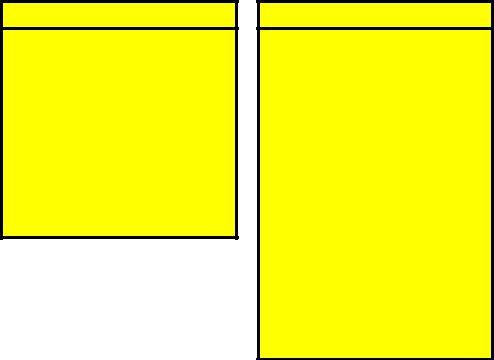
Part 1 OPERATION OF
INSTRUMENTS AND CONTROLS—
Chapter 1−3 Seats, Seat belts, Steering wheel and Mirrors
DSeats
DFront seats
DFold−down rear seat
DSeat belts
DSRS driver and front passenger airbags
DChild restraint
DTilt steering wheel
DOutside rear view mirrors
DAnti−glare inside rear view mirror
SUPRA (U)
Seats
While the vehicle is being driven, all vehicle occupants should have the seatback upright, sit well back in the seat and properly wear the seat belts provided.
Front seats—
—Seat adjustment precautions
Adjust the driver’s seat so that the foot pedals, steering wheel and instrument panel controls are within easy reach of the driver.
 CAUTION
CAUTION
DDo not drive the vehicle unless the occupants are not properly seated. Do not allow sitting on top of a folded−down seatback, or in the luggage compartment. Persons not properly seated and not properly restrained by seat belts can be severely injured in the event of emergency braking or a collision.
DDuring driving, do not allow passengers to stand up or move around between seats. Severe injuries can occur in the event of emergency braking or a collision.
 CAUTION
CAUTION
DAdjustments should not be made while the vehicle is moving, as the seat may unexpectedly move and cause the driver to lose control of the vehicle.
DWhen adjusting the seat, be careful not to hit the seat against a passenger, luggage or rear seat.
D After adjusting the seat position, try sliding it forward and backward to make sure it is locked in position.
DAfter adjusting the seatback, exert body pressure to make sure it is locked in position.
DDo not put objects under the seats. The objects may interfere with the seat−lock mechanism or unexpectedly push up the seat position adjusting lever; the seat may suddenly move, causing the driver to lose control of the vehicle.
23

DWhile adjusting the seat, do not put your hands under the seat or near the moving parts. You may catch and injure your hands or fingers.
SUPRA (U)
—Adjusting front seat (manual seat)
ADJUSTING SEAT POSITION
Pull the lock release lever up. Then slide the seat to the desired position with slight body pressure and release the lever.
ADJUSTING SEATBACK ANGLE
Lean forward and pull the lock release lever. Then lean back to the desired angle and release the lever.
 CAUTION
CAUTION
To reduce the risk of sliding under the lap belt during a collision, avoid reclining the seatback any more than needed. The seat belts provide maximum protection in a frontal or rear collision when the driver and the passenger are sitting up straight and well back in the seats. If you are reclined, the lap belt may slide past your hips and apply restraint forces directly to the abdomen. Therefore, in the event of a frontal collision, the risk of personal injury may increase with increasing recline of the seatback.
24
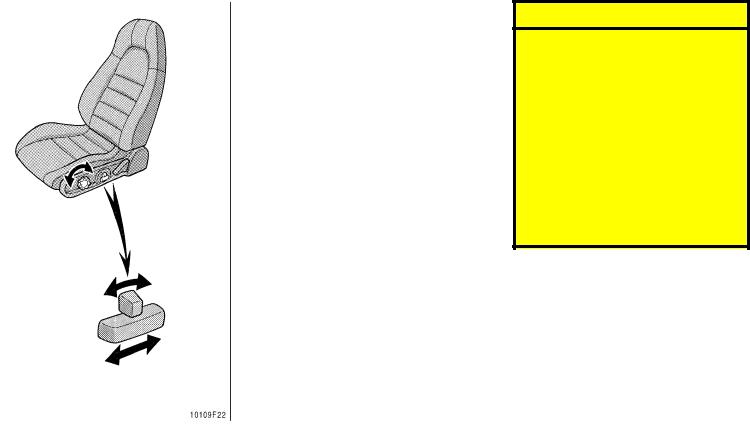
—Adjusting front seat (power seat)
ADJUSTING SEAT POSITION
Move the control switch to the desired direction.
Releasing the switch will stop the move in that position.
Do not place anything under the front seats. It might interfere with the seat movement.
ADJUSTING SEATBACK ANGLE
Move the control switch to the desired direction.
Releasing the switch will stop the move in that position.
SUPRA (U)
 CAUTION
CAUTION
To reduce the risk of sliding under the lap belt during a collision, avoid reclining the seatback any more than needed. The seat belts provide maximum protection in a frontal or rear collision when the driver and the passenger are sitting up straight and well back in the seats. If you are reclined, the lap belt may slide past your hips and apply restraint forces directly to the abdomen. Therefore, in the event of a formal collision, the risk of personal injury may increase with increasing recline of the seatback.
ADJUSTING SEAT CUSHION ANGLE
Turn the knob either way.
25

—Tilting driver’s seatback for rear seat entry
Lift the seatback lock release lever—the seatback will tilt forward.
This allows passengers to get into or out of the rear seat easily. After passengers are in, lift up on the seatback.
 CAUTION
CAUTION
After putting back the seatback, try pushing the seatback forward and rearward to make sure it is secured in place.
SUPRA (U)
—Moving passenger’s seat for rear seat entry
For easy access to the rear seat, do this.
1.Lift the seatback lock release lever or press the release pedal.
The seat will slide forward slightly.
2.Move the seat to the front−most position.
After passengers are in, lift up the seatback and return the seat until it locks.
 CAUTION
CAUTION
DAfter putting back the seat, try pushing the seat forward and rearward to make sure it is secured in place.
D Never |
allow anyone to rest their |
foot on the release pedal while the |
|
vehicle |
is moving. |
26
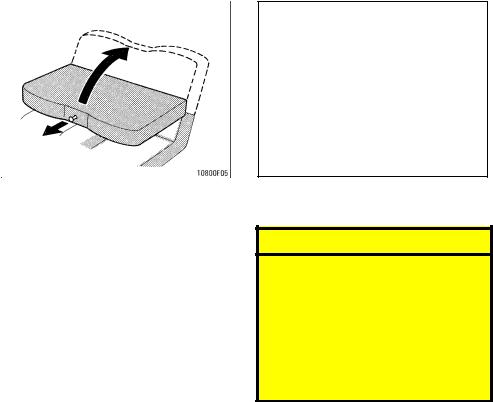
Fold−down rear seat
FOLDING DOWN REAR SEAT
Unlock the seatback, and fold it down.
This will enlarge the luggage compartment as far as the front seatbacks. See ”Luggage stowage precautions” in Part 2 for precautions to observe in loading luggage.
SUPRA (U)
SETTING UP REAR SEAT
Unlock the seatback, and set it up.
 CAUTION
CAUTION
When returning the seatback to the upright position:
DMake sure the seat belts are not twisted or caught in the seatback and are arranged in their proper position for ready use.
DMake sure the seatback is securely locked by pushing forward and rearward on the top of the seatback.
Seat belts—
—Seat belt precautions
Toyota strongly urges that the driver and passengers in the vehicle be properly restrained at all times with the seat belts provided. Failure to do so could increase the chance of injury and/or the severity of injury in accidents.
Child. Use a child restraint system appropriate for the child until the child becomes large enough to properly wear the vehicle’s seat belts. See ”Child restraint” for details.
If a child is too large for a child restraint system, the child should sit in the rear seat and must be restrained using the vehicle’s seat belt. According to accident statistics, the child is safer when properly
restrained |
in the |
rear |
seat than in |
the |
|
front |
seat. |
|
|
|
|
If a |
child |
must sit |
in |
the front seat, |
the |
seat belts should be worn properly. If an accident occurs and the seat belts are not worn properly, the force of the rapid inflation of the airbag may cause death or serious injury to the child.
27
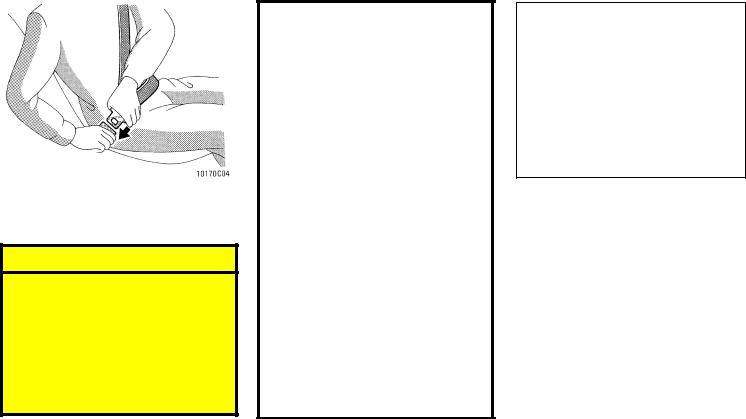
Do not allow the child to stand up or kneel on either rear or front seats. An unrestrained child could suffer serious injury or death during emergency braking or a collision. Also, do not let the child sit on your lap. It does not provide sufficient restraint.
Pregnant woman. Toyota recommends the use of a seat belt. Ask your doctor for specific recommendations. The lap belt should be worn securely and as low as possible over the hips and not on the waist.
Injured person. Toyota recommends the use of a seat belt. Depending on the injury, first check with your doctor for specific recommendations.
 CAUTION
CAUTION
Persons should ride in their seats properly wearing their seat belts whenever the vehicle is moving. Otherwise, they are much more likely to suffer serious bodily injury or death in the event of sudden braking or a collision.
When using the seat belts, observe the following:
SUPRA (U)
DUse the belt for only one person at a time. Do not use a single belt for two or more people—even children.
DAvoid reclining the seatbacks too
much. The seat belts provide maximum protection when the seatbacks are in the upright position. (Refer to the seat adjustment instructions.)
DBe careful not to damage the belt webbing or hardware. Take care that they do not get caught or pinched in the seat or doors.
DInspect the belt system periodically. Check for cuts, fraying, and loose parts. Damaged parts should be replaced. Do not disassemble or modify the system.
DKeep the belts clean and dry. If they need cleaning, use a mild soap solution or lukewarm water. Never use bleach, dye, or abrasive clean- ers—they may severely weaken the belts.
DReplace the belt assembly (including bolts) if it has been used in a severe impact. The entire assembly should be replaced even if damage is not obvious.
—Seat belts
Adjust the seat as needed (front seats only) and sit up straight and well back in the seat. To fasten your belt, pull it out of the retractor and insert the tab into the buckle.
You will hear a click when the tab locks into the buckle.
The seat belt length automatically adjusts to your size and the seat position.
The retractor will lock the belt during a sudden stop or on impact. It also may lock if you lean forward too quickly. A slow, easy motion will allow the belt to extend, and you can move around freely.
28

SUPRA (U)
If the seat belt cannot be pulled out of the retractor, firmly pull the belt and release it. You will then be able to smoothly pull the belt out of the retractor.
When a passenger’s shoulder belt is completely extended and is then retracted even slightly, the belt is locked in that position and cannot be extended. This feature is used to hold the child restraint system securely. (For details, see ”Child restraint” in this chapter.) To free the belt
again, fully |
retract the belt and then pull |
the belt out |
once more. |
 CAUTION
CAUTION
DAfter inserting the tab, make sure the tab and buckle are locked and that the belt is not twisted.
DDo not insert coins, clips, etc. in the buckle as this may prevent you from properly latching the tab and buckle.
DIf the seat belt does not function normally, immediately contact your Toyota dealer. Do not use the seat until the seat belt is fixed. It cannot protect an adult occupant or your child from injury.
Adjust the position of the lap and shoulder belts.
Position the lap belt |
as low as |
possible |
on your hips—not on |
your waist, |
then ad- |
just it to a snug fit by pulling the shoulder portion upward through the latch plate.
 CAUTION
CAUTION
D High−positioned lap belts and loose−fitting belts both could cause serious injuries due to sliding under the lap belt during a collision or other unintended result. Keep the lap belt positioned as low on hips as possible.
DFor your safety, do not place the shoulder belt under your arm.
29
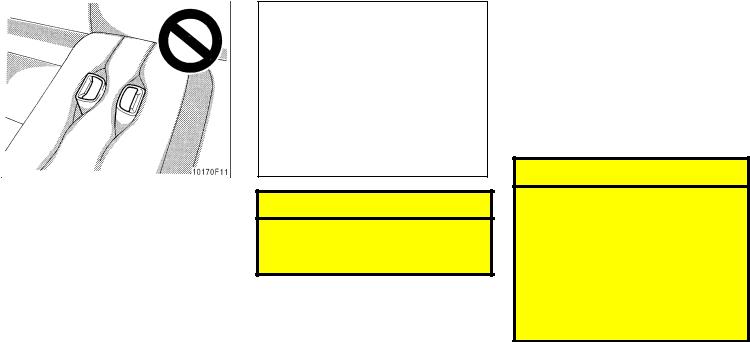
To release the belt, press the buckle−release button and allow the belt to retract.
If the belt does not retract smoothly, pull it out and check for kinks or twists. Then make sure it remains untwisted as it retracts.
SUPRA (U)
 CAUTION
CAUTION
For your safety, do not use the rear seat belts with the buckle in the rear seats.
—Seat belt extender
If your seat belt cannot be fastened securely because it is not long enough, a personalized seat belt extender is available from your Toyota dealer free of charge.
Please contact your local Toyota dealer so that the dealer can order the proper required length for the extender. Bring the heaviest coat you expect to wear for proper measurement and selection of length. Additional ordering information is available at your Toyota dealer.
 CAUTION
CAUTION
When using the seat belt extender, observe the following. Failure to follow these instructions could result in less effectiveness of the seat belt restraint system in case of vehicle accident, increasing the chance of personal injury.
DNever use the seat belt extender if you can fasten the seat belt without it.
30
